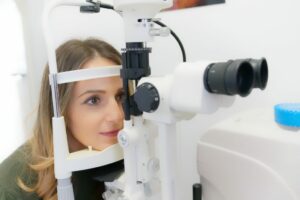Out of all the differences there are between men and women, the risk of developing eye diseases isn’t one that usually comes to mind. However, women do account for more cases of eye diseases than men, and the organization Prevent Blindness has designated April as Women’s Eye Health and Safety Month in an effort to educate women about these issues and offer tips on caring for their vision. 
Specifically, there are 3 eye diseases that women are diagnosed with more than men and that cause permanent vision loss if left untreated:
- Glaucoma, which causes gradual loss of peripheral vision
- Age-related macular degeneration, which causes the gradual loss of central vision
- Cataracts, which causes vision to cloud or become obscured
In the U.S., women account for more than half of several serious eye diseases as well as the majority of more common eye conditions. Prevent Blindness reports that women represent:
- 66% of people who are legally blind
- 65% of age-related macular degeneration cases
- 63% of people with vision impairment
- 61% of both glaucoma patients
- 61% of cataract patients
- 56% of people with refractive errors (nearsightedness, farsightedness, astigmatism, and presbyopia)
Women’s Eye Health Risk Factors
Women have a higher risk of developing eye diseases like glaucoma, age-related macular degeneration, and cataracts in large part because they tend to live longer, and these are eye diseases that are more likely to increase as we age. In addition, women have higher rates of autoimmune diseases than men—many of which affect vision—such as lupus, hyperthyroiditis, and Sjögren’s syndrome.
Hormones are also influential for women’s eye health, since pregnancy, birth control, and menopause affect hormone levels that can affect vision. Hormonal changes also lead to dry eye syndrome. In fact, postmenopausal women have 2x the rate of dry eye syndrome than men do.
Women’s Eye Health Tips
There are certain steps that women can take to protect their vision and eye health, the most crucial of which is getting regular eye exams, especially as they age. Annual eye exams are the best way for eye doctors to detect early signs of eye diseases that can cause permanent vision loss, including glaucoma, age-related macular degeneration, and cataracts. Early detection allows for proper treatment in order to preserve vision. Recommendations that help women be proactive about the health of their eyes include:
- Have annual eye exams, beginning by age 40
- Know your family history of eye diseases
- Do not smoke
- Wear 100% UV-blocking sunglasses
- Eat a diet low in fat and rich in fruits, vegetables, and whole grains
Again, the most important thing that women can do is to stay on top of regular eye exams. Eye diseases often develop without any obvious signs or symptoms until vision loss is permanent. Comprehensive, annual eye exams with an optometrist are the only way to accurately diagnose an eye disorder or disease and then determine proper treatment when necessary.
In addition, through regular eye exams, eye doctors are able to identify early signs of more than 270 different health issues and diseases—such as heart disease, diabetes, high blood pressure, autoimmune disorders, and certain kinds of cancer.
Located at 10904 Spring Bluff Way off Hardin Valley Road, Hardin Valley Eyecare & Optical has provided the highest quality vision care products and trusted optometry services to our patients in Knoxville and the surrounding areas since 2009. Our eye care professionals are dedicated to providing exceptional personal service to each and every person who walks through our door. Call us at (865) 409-1253 or contact us to schedule your appointment.





